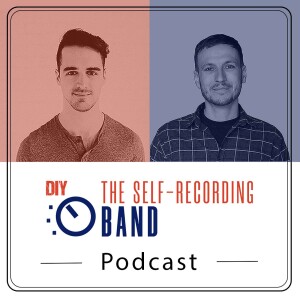
Send us a text
BOOK A FREE IN-DEPTH 1-ON-1 FEEDBACK CALL WITH BENEDIKT:
https://theselfrecordingband.com/call
Join the free Facebook Group ("The Self-Recording Band Community"):
https://theselfrecordingband.com/community
Benedikt's voice on this episode has been recorded with the Antelope Axino Synergy Core
--
In this episode we’re showing you what to look for in a vocal mic and how to find the right mic for your room and voice.
Picking the right mic is crucial because if you choose the wrong one, it’s very hard (if not impossible) to make it sound great in the mix. We’re explaining the reasons for this and give you examples of the most common problems.
Things we cover in the episode:
- Make sure the mic is not too sibilant/bright. When in doubt, darker is better.
- Know your room and avoid condensers if you’re in an untreated or bad sounding room (most rooms).
- Learn about pickup patterns and choose a mic with the right pattern for your situation. In most cases: Cardiod.
- Know your genre and think about the sound you’re going for. Bright? Dark? Polished? Airy? Gritty? Distorted? Modern? Vintage? Do some research on classic mics and popular choices for certain styles.
- You’ll find that a lot of the classic options are super expensive. Resist the temptation to by a cheap knock-off or cheap condensers in general, with only a few exceptions. If you can afford the high-end mics, perfect! If not, save up or get a good dynamic mic. There are some good affordable condensers, but you really have to do some research and pick one that matches your voice. So be careful.
- For many people using a dynamic vocal mic is actually a really great idea! Especially in heavier genres and in a DIY recording setup at home.
- If you can, try a few options before you buy one. Every voice is different. And every room, too.
Here are 3 reason why we often recommend good dynamic vocal mics to self-recording bands:
- Value for money. Good dynamic mics, like a Shure SM7B, a Røde Procaster, an Aston Stealth, an Electro Voice RE20, etc. typically sound better than condensers in the same price range. If you go with a condenser, you’ll probably have to invest a little more.
- Most rooms are problematic, especially if you record at home or in the jam space, you'll probably have to make the most out of a less-than-ideal acoustic situation. Dynamics are much better for this, as they are far less sensitive and don’t capture as much of the room sound and noise as condensers do.
- Aggressive vocals are typically a good fit for dynamics because of the "gritty" midrange character and smooth top end of those mics. Condensers can sound a little too detailed for this, sometimes a little harsh, sibilant or brittle and some lack the punch and grit in the mids. Not true for every vocalist and every mic, but for many of them, especially with budget condensers.
At the end of the day, you'll have to try and find out what works best with your voice, your style of music and in your room. Just don't think you have to use a condenser, even if that's what you see in most studio pictures.
Google "records made with an SM7" and you'll probably feel a lot more comfortable about using a dynamic mic.
For full show notes go to: https://
If you have any questions, feedback, topic ideas or want to suggest a guest, email us at: podcast@theselfrecordingband.com
More Episodes
Create your
podcast in
minutes
- Full-featured podcast site
- Unlimited storage and bandwidth
- Comprehensive podcast stats
- Distribute to Apple Podcasts, Spotify, and more
- Make money with your podcast
It is Free
- Privacy Policy
- Cookie Policy
- Terms of Use
- Consent Preferences
- Copyright © 2015-2024 Podbean.com







